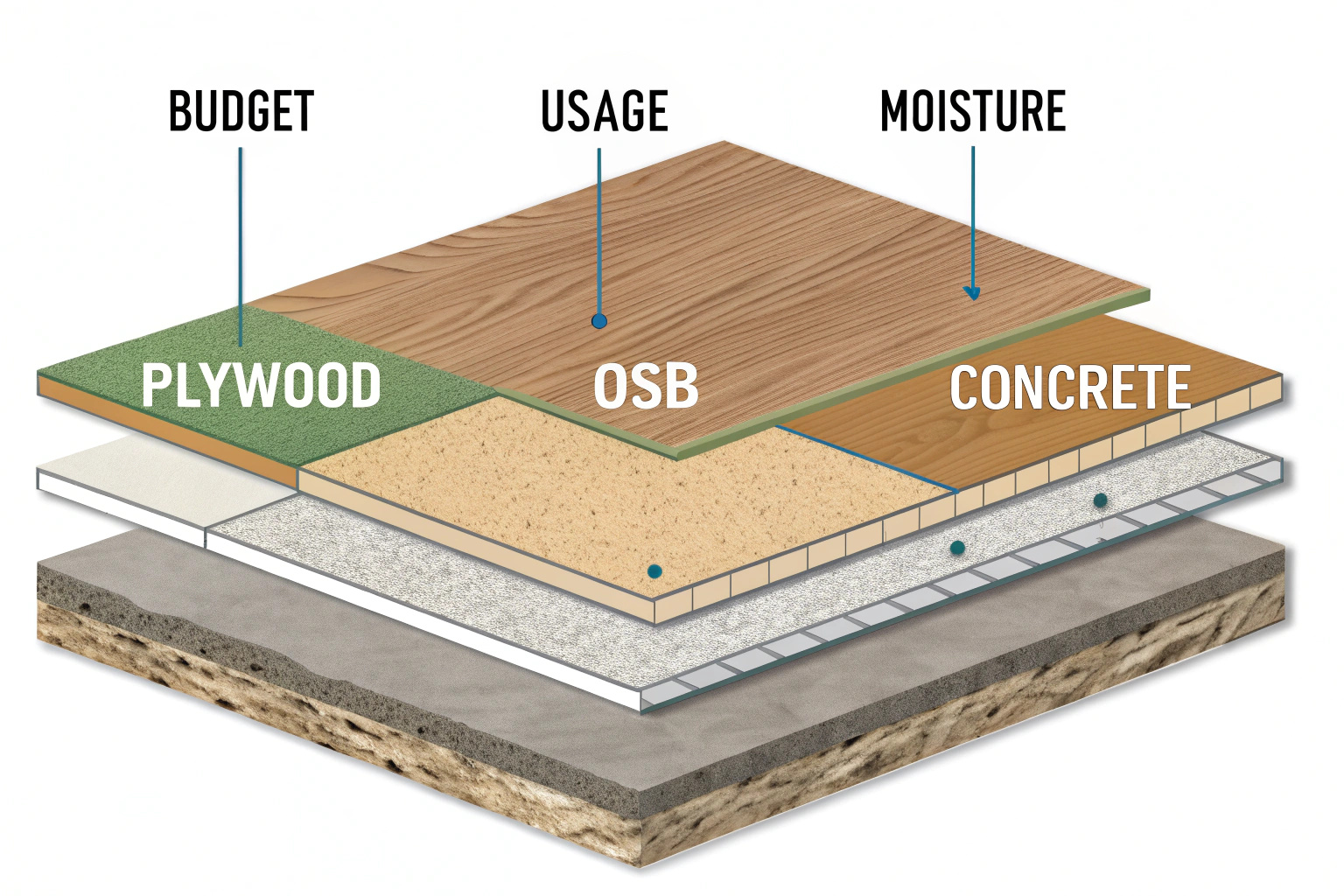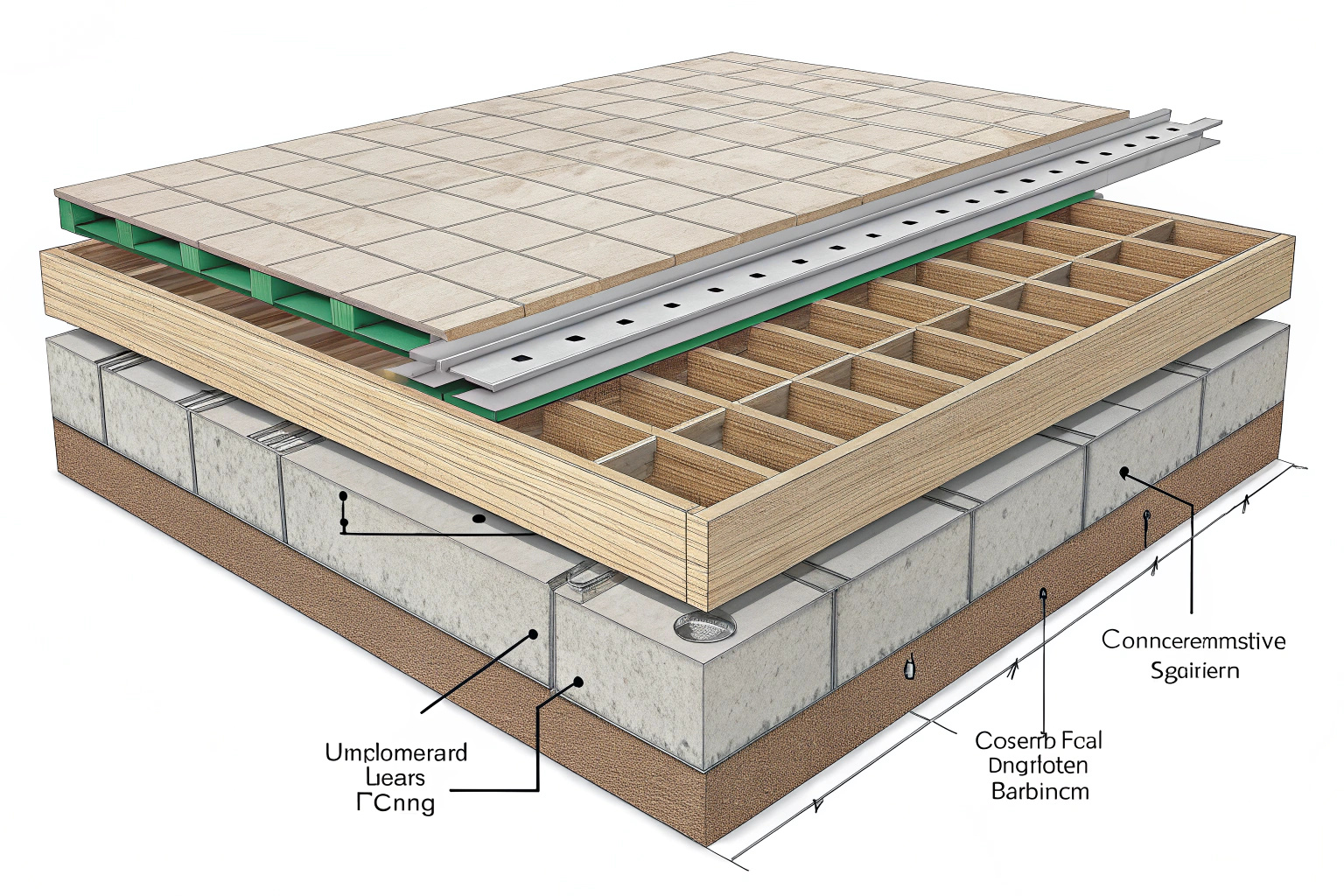
Your choice of subfloor can affect your flooring’s longevity, comfort, and structural stability. Picking the right material depends on budget, usage, and moisture exposure.
The best subfloor material depends on the type of finish flooring, location, and expected moisture levels. Plywood, OSB, and concrete each offer advantages in different scenarios.
When renovating or building a new floor system, what lies beneath—the subfloor—matters just as much as the visible surface. A good subfloor provides support, resists movement, and serves as a base for flooring materials like hardwood, vinyl, or tile. Choosing the wrong type can lead to squeaks, uneven surfaces, and even structural issues over time. So how do you make the right decision?
✔
Concrete is ideal for basements and slab-on-grade foundations due to its moisture resistance and stability.
✖
While OSB is cheaper and offers good strength, plywood has better moisture resistance and handles fasteners better in many situations.
What Role Does a Subfloor Play?

The subfloor acts as the foundational layer beneath your visible flooring. It lies directly above the floor joists and beneath underlayment or finished flooring. This structural layer ensures your flooring system is stable, evenly supported, and capable of bearing weight without flexing.
While the subfloor is usually hidden, its performance affects nearly every aspect of the room above it. Creaking floors, tile cracks, and even moisture issues often trace back to subfloor problems. That’s why choosing the right material is critical—it determines how the entire floor system performs over time.
Key Factors to Consider When Choosing a Subfloor
Selecting a subfloor isn’t a one-size-fits-all process. It depends on the room’s location, the type of finished flooring, the likelihood of moisture exposure, and of course, your budget.
Moisture Exposure – Areas like bathrooms, basements, or kitchens are more prone to moisture. Materials like concrete or moisture-rated plywood perform better in such environments.
Flooring Type – Tile demands a stiff, stable base to prevent cracking. Carpet and vinyl are more forgiving but still require a smooth, level surface.
Structural Support – Thicker subfloor panels (like 3/4" plywood) are better at spanning joists without flexing. This is important for second-story floors or large spans between joists.
Budget Constraints – OSB is generally more affordable than plywood but may come with trade-offs in performance, especially in wet conditions.
Installation Conditions – Time and labor also play a role. Some subfloor systems are easier to install or come with tongue-and-groove edges for quicker setup.
Comparing Common Subfloor Materials
Each subfloor material has its pros and cons. Understanding their differences helps match the right option to your project’s requirements.
Plywood
Plywood is made of cross-laminated layers of wood veneer, giving it strength and dimensional stability. It holds screws well, resists swelling, and is easy to cut and install.
Best For: Areas exposed to occasional moisture, higher-end construction, and under hardwood or tile.
Advantages: Better moisture resistance than OSB, stiffer, holds fasteners well.
Drawbacks: Higher cost than OSB.
Oriented Strand Board (OSB)
OSB is engineered from compressed wood strands and resin. It’s strong and affordable, making it a common choice in new home construction.
Best For: Dry areas, budget-conscious builds, and large floor areas.
Advantages: Cost-effective, uniform thickness, smooth surface.
Drawbacks: Swells when wet, weaker edge strength than plywood.
Concrete
Concrete slabs are often used as subfloors in basements or on the ground floor of slab-on-grade homes.
Best For: Below-grade applications, radiant floor systems, high-moisture environments.
Advantages: Doesn’t warp or swell, long-lasting, mold-resistant.
Drawbacks: Requires moisture barriers, hard to modify or repair, cold underfoot.
Subfloor Recommendations by Flooring Type
Your choice of finish flooring affects which subfloor material is ideal. Matching them ensures better performance and fewer issues over time.
For hardwood flooring, plywood is preferred because it provides solid nail retention and resists movement. Engineered hardwood may also perform well over OSB, provided it’s in a dry area.
For ceramic or porcelain tile, the subfloor must be extremely rigid. Plywood with a cement backer board or concrete is usually the safest option. OSB can be used if properly reinforced, but extra preparation is required.
Vinyl and laminate floors are more forgiving but still benefit from smooth, level subfloors. OSB works well, especially with an underlayment, although plywood provides better long-term stability.
Carpet is the least demanding but still needs a smooth base. Both OSB and plywood perform well, though some installers prefer plywood for staple or tack strip anchoring.
Mistakes to Avoid When Selecting a Subfloor
Not all subfloors are created equal, and the wrong choice can cause expensive problems down the line. One of the most common mistakes is underestimating the impact of moisture. Using standard OSB or untreated plywood in damp environments almost always leads to swelling and delamination.
Another mistake is failing to match the subfloor thickness to joist spacing. Using thinner panels on wide joist spans can cause flexing, leading to cracked tiles or squeaky floors. Always refer to local building codes or consult a structural engineer for appropriate thickness recommendations.
It’s also important not to assume all underlayments or finished floors will hide subfloor flaws. A bumpy, uneven subfloor will eventually show through or damage the finished surface. Proper prep and leveling are essential, no matter which material you choose.
Conclusion
Choosing the right subfloor material is about more than just what’s cheapest or most available. It’s about moisture tolerance, structural strength, compatibility with your finished flooring, and long-term performance.
Plywood is a great all-around performer, especially in areas where moisture resistance and nail-holding strength matter. OSB offers a budget-friendly alternative, ideal for dry spaces and large coverage areas. Concrete is unmatched in damp conditions and slab-on-grade construction.
By carefully weighing your project’s needs—room usage, flooring type, environmental factors—you’ll make a decision that supports not just your floors, but the overall integrity of your home.
